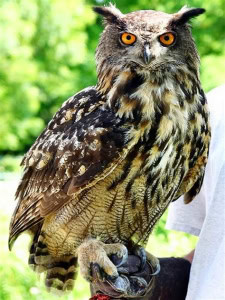Book Review: Owls of the Eastern Ice
by Bonnie Tollefson
Editor’s note: this review was originally released with authorship mistakenly attributed to Jan Hines. The Complement apologizes to Bonnie, Jan, and our readers for the error.
Subtitled: A Quest to Find and Save the World’s Largest Owl, by Jonathan C. Slaght, Center Point Large Print, 2020
The first thing I learned from this book was – Don’t make life decisions while hiking in the blazing sun in a bug infested bog – you could end up spending years freezing off valuable  body parts. That is what Jonathan Slaght did. He had fallen in love with the Primorye region of Russia. For those of you as deficient as I am regarding Russian geography, that is the area to the East of Siberia. It is bordered by China, North Korea and the Sea of Japan.
body parts. That is what Jonathan Slaght did. He had fallen in love with the Primorye region of Russia. For those of you as deficient as I am regarding Russian geography, that is the area to the East of Siberia. It is bordered by China, North Korea and the Sea of Japan.  Jonathan spent 3 years there during his time in the Peace Corps and also did a Masters project for the University of Minnesota on the effect of logging in the area on songbirds. As he was trying to decide on a subject for his doctoral dissertation, it came down to aiding the conservation efforts for two birds – the hooded crane and the fish owl. Since that hot buggy bog was prime hooded crane habitat he decided to study the fish owl. Never heard of a fish owl? It is the largest of the owl family being over two feet tall with a six foot wingspan and scruffy brown feathers that blend very well into their forested habitat. Their primary food source is fish and frogs so their hearing is not as good as other owls. The easiest time to locate them is February when they leave their distinctive tracks on the side of rivers and make their eerie duet calls during mating. These facts led Slaght to spend five winters in the forests of the Primorye as he located nest trees, studying habitat, and captured live owls. He took measurements, finally discovered how to tell apart the male and female (it’s more white tail feathers), banded birds and, on a few owls, placed expensive GPS transmitters to determine flight patterns. In spite of bears, tigers, and temperatures well below 0, Slaght and his Russian research assistants were able to work out a conservation plan for loggers and others to protect this owl found only in Russia and northern Japan.
Jonathan spent 3 years there during his time in the Peace Corps and also did a Masters project for the University of Minnesota on the effect of logging in the area on songbirds. As he was trying to decide on a subject for his doctoral dissertation, it came down to aiding the conservation efforts for two birds – the hooded crane and the fish owl. Since that hot buggy bog was prime hooded crane habitat he decided to study the fish owl. Never heard of a fish owl? It is the largest of the owl family being over two feet tall with a six foot wingspan and scruffy brown feathers that blend very well into their forested habitat. Their primary food source is fish and frogs so their hearing is not as good as other owls. The easiest time to locate them is February when they leave their distinctive tracks on the side of rivers and make their eerie duet calls during mating. These facts led Slaght to spend five winters in the forests of the Primorye as he located nest trees, studying habitat, and captured live owls. He took measurements, finally discovered how to tell apart the male and female (it’s more white tail feathers), banded birds and, on a few owls, placed expensive GPS transmitters to determine flight patterns. In spite of bears, tigers, and temperatures well below 0, Slaght and his Russian research assistants were able to work out a conservation plan for loggers and others to protect this owl found only in Russia and northern Japan.
The book is available thru the Jackson County Public Library and as Large Print from the RVM Library.








Leave a Reply
Want to join the discussion?Feel free to contribute!